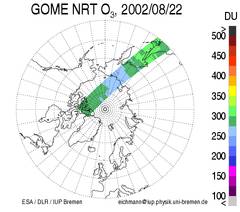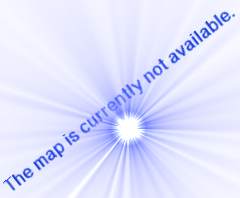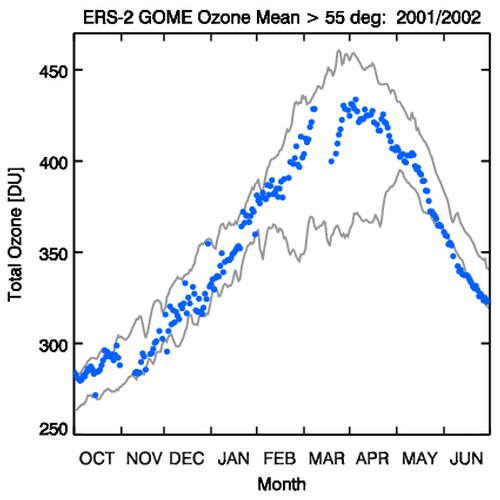GOME NRT Ozone Total Columns and Profiles
Please note that these maps are small versions and that each map is clickable. A new window will appear with the normalsized jpg-version of the map. You should use a browser with activated JavaScript. Otherwise go to the Archive section down below, where a data page for each day is available. A brief overview on the NRT ozone retrieval can also be found further down below.
NOTE: The ERS-2 platform is operating in gyroless mode since February 2001. Attitude and pointing control is now achieved using digital earth sensors and payload data. Several refinements of the software have been improving the ERS2 performance. Nevertheless, passive tracking of the sun on a daily basis is not always possible. Extended periods of no direct solar measurements in combination with several cooler switchings can lead to artificial spectral structures in the sun-normalised eartshine nadir radiances impacting the trace gas retrieval. The quality of all trace gas data products presented here may be reduced. For most recent news on ERS2 performance contact ESA/ESRIN web pages.
All results on this page are preliminary!



This picture shows
the daily mean ozone north of 55 deg for the winter/spring period from
November till June. The grey lines mark the min/max values of the GOME
years 1995-2001.
Archive
December 2001 January 2002 February 2002
Mo Tu We Th Fr Sa Su Mo Tu We Th Fr Sa Su Mo Tu We Th Fr Sa Su
1 2 1 2 3 4 5 6 1 2 3
3 4 5 6 7 8 9 7 8 9 10 11 12 13 4 5 6 7 8 9 10
10 11 12 13 14 15 16 14 15 16 17 18 19 20 11 12 13 14 15 16 17
17 18 19 20 21 22 23 21 22 23 24 25 26 27 18 19 20 21 22 23 24
24 25 26 27 28 29 30 28 29 30 31 25 26 27 28
31
March 2002 April 2002 May 2002
Mo Tu We Th Fr Sa Su Mo Tu We Th Fr Sa Su Mo Tu We Th Fr Sa Su
1 2 3 1 2 3 4 5 6 7 1 2 3 4 5
4 5 6 7 8 9 10 8 9 10 11 12 13 14 6 7 8 9 10 11 12
11 12 13 14 15 16 17 15 16 17 18 19 20 21 13 14 15 16 17 18 19
18 19 20 21 22 23 24 22 23 24 25 26 27 28 20 21 22 23 24 25 26
25 26 27 28 29 30 31 29 30 27 28 29 30 31
|
Overview
GOME near real time (NRT) total ozone data are directly processed by the GDP (GOME Data Procesor) installed at ESA's Kiruna ground station, by applying the DOAS (Differential Optical Absorption Spectroscopy) algorithm to GOME Level-1 spectra.
GOME NRT ozone profiles are produced at the Institute of Environmental Physics and Remote Sensing, University of Bremen using the FURM algorithm on GOME NRT Level-1 radiances and irradiances. The FURM (FUll Retrieval Method) is an advanced Optimal Estimation inversion scheme to derive ozone profiles from the UV spectra. FURM consists of two major parts: (a) a forward model: the pseudo-spherical multiple scattering radiative transfer model (RTM) GOMETRAN++, calculating the top of atmosphere (TOA) radiance for a given state of the atmosphere, and (b) an iterative inversion scheme, that adjusts this state to match the calculated with the measured TOA radiance, utilizing the so-called weighting functions also provided by GOMETRAN. Because this inversion problem is under-constrained, an optimal estimation approach was chosen, which combines the information from the measurement with statistical a-priori information from a climatology.
For good results, reliable information about the meteorological conditions, e.g. temperature and pressure profiles, is needed. Temperature profiles are taken from actual forecasts provided by ECMWF and DWD.
FURM profile retrieval is currently limited to solar zenith angles less than 75 degree, thus good polar coverage is not achieved until late winter.
References:
- K. Bramstedt, K.-U. Eichmann, M. Weber, R. Hoogen, V. Rozanov, and J.P. Burrows, Ozone depletion in the Arctic spring calculated from GOME Ozone Profiles, European Symposium on Atmospheric Measurements from Space, Proc. ESAMS'99, ESA-WPP-161, 225-229, 1999.
- H. Bremer, M. von König, A. Kleinböhl, H. Küllmann, K. Künzi, K. Bramstedt, J. P. Burrows, K.-U. Eichmann, M. Weber, A. P. H. Goede, Ozone depletion observed by ASUR during the Arctic Winter 1999/2000, J. Geophys. Res., in press, 2001.
- K.-U. Eichmann, K. Bramstedt, M. Weber, R. Hoogen, V.V. Rozanov, and J.P. Burrows, Structure of ozone mini-holes from GOME, European Symposium on Atmospheric Measurements from Space, Proc. ESAMS'99, ESA-WPP-161, 231-236, 1999.
- K.-U. Eichmann, K. Bramstedt, M. Weber, V.V. Rozanov, R. Hoogen and J.P. Burrows, O3 profiles from GOME satellite data - II: Observations in the Arctic spring 1997 and 1998, Physics and Chemistry of the Earth 24, 453-457, 1999.
- K.-U. Eichmann, M. Weber, K. Bramstedt, and J.P. Burrows, Ozone depletionin the NH winter/spring 1999/2000 as measured by GOME-ERS2, J. Geophys. Res., submitted 2001.
- R. Hoogen, V.V. Rozanov, J.P. Burrows, Ozone Profiles from GOME Satellite Data: Algorithm Description and First Validation, J. Geophysical Research, 104, 8263-8280, 1999.
- R. Hoogen, V.V. Rozanov, K. Bramstedt, K.-U. Eichmann, M. Weber, and J.P. Burrows, Ozone profiles from GOME satellite data-I: Comparison with ozonesonde measurements, Physics and Chemistry of the Earth 24, 447-452, 1999.
- M. Weber, K.-U. Eichmann, F. Wittrock, K. Bramstedt, L. Hild, A. Richter, J.P. Burrows, and R. Müller, The cold Arctic winter 1995/96 as observed by the Global Ozone Monitoring experiment GOME and HALOE: Tropospheric wave activity and chemical ozone loss, accepted for publication in Q. J. Roy. Meteor. Soc., 2001.
Last change: 12/14/2001
Contact:
Klaus Bramstedt, Kai-Uwe Eichmann, and Mark Weber.